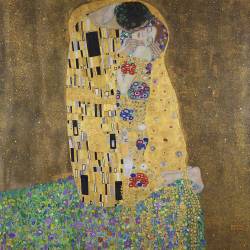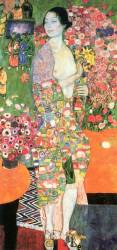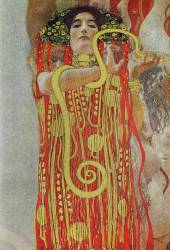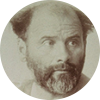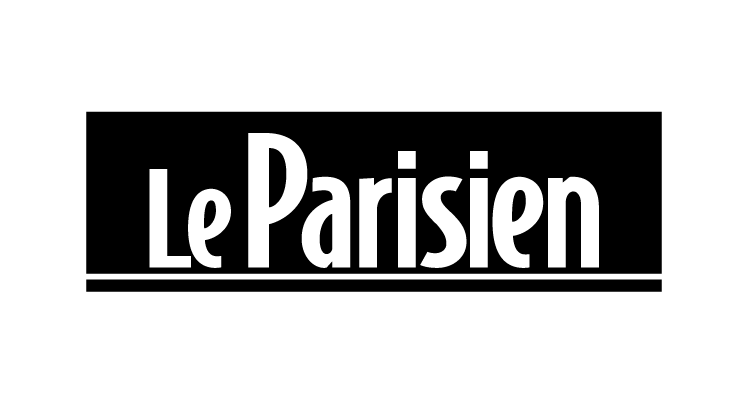Artwork of Gustav Klimt canvas prints & artprints
A precursor and instigator of Viennese art at the end of the 19th century, Klimt left his mark on a whole fringe of Western Symbolist painting. With his daring themes, and his desire to unite the fine and figurative arts without distinction, the artist left behind a collection of countless paintings, decorations and frescoes that earned him the recognition of an entire public, but also the criticism of a section of the art world.
Discover the most beautiful paintings by the leader of the Viennese Secession available in the catalog, including the famous "Kiss", an emblematic painting from Klimt's golden period, "The Beethoven Frieze", a fresco symbolizing total art, and "The Portrait of Emilie Flöge", a personal work by the woman who accompanied him for most of his life. Treat yourself to an art reproduction of the genius of Symbolist painting and Austrian Art Nouveau, and discover his biography.
Biography of Gustav Klimt
Early life: Gustav Klimt the decorator
The son of a goldsmith and metal chiseler, and an Austrian mother with a passion for opera, Gustav Klimt was born in 1862, at the end of the 19th century, into a family of artists living in poverty, who lacked the success and renown their son would enjoy as a great Austrian Symbolist painter.
From an early age, Gustav developed a passion for drawing, and helped his father in his trade as a goldsmith, which led relentlessly to his entry into the School of Applied Arts in Vienna, where he was trained in academicism and portrait reproductions. Following his training, at just 17, he took up his first position as a decorative painter, where, accompanied by a team led by the famous decorator Hans Makart, and including his brothers and friend Franz Matsch, he produced his first compositions, frescoes and murals, notably decorating the interior and exterior courtyard of the Museum of Art History, or the allegories commissioned for the ceilings of Vienna's Sturany Palace.
Following the death of their mentor Hans Makart, Klimt and the rest of his team gained a growing reputation for their decorations, which combined the precise academicism of Gustav Klimt and Franz Matsch with the meticulous goldsmithing of Gustav's brother Ernst. They were frequently called upon to decorate iconic buildings with their murals, frescoes and large-format allegorical paintings, from the Villa Hermes and the Burgtheater in Vienna to theaters in Karlsbad and Fiume in Europe. Gustav Klimt even achieved recognition in the highest spheres, receiving the Golden Cross of Artistic Merit from the Austrian Emperor, definitively establishing him as one of the great decorative painters of his time.
From Academism to the Vienna Secession: Gustav Klimt at the forefront of Viennese art
After the death of his father and brother, Gustav Klimt became increasingly inspired by Japanese prints, French Impressionism, Art-Nouveau and European Symbolism, and began to focus on ever more original works, provoking a divergence between himself and his contemporaries still rooted in academicism. Drawing on his experience in the decorative arts, Klimt increasingly wanted to instill a new way of looking at the fine and minor arts, creating a total art movement that would unite them all without distinction.
The Viennese Secession thus took shape around a group of artists, with Klimt himself as president and leader of the movement, architects Joseph Maria Olbrich and Josef Hoffmann, painters Carl Moll and Max Kurzweil, and decorator Koloman Moser, among others. The Viennese Secessionists were at the forefront of art in Europe, and put Austria and Vienna in the spotlight. They even went so far as to create their own Secession Palace, a place designed to allow figurative artists outside the shackles of traditional academic painting a first exhibition and permanent display of their work, without censorship, and leaving room for creativity and total art.
Gold, eroticism and mythology at the heart of Gustav Klimt's work
Klimt's mix of techniques and fascination with figurative art led him to develop themes that recurred throughout his work with the Secessionists. The most striking of these was undoubtedly the use of gold leaf in his paintings. These original ornaments, inspired by the great Byzantine frescoes, were to play a major role in what came to be known as "The Golden Cycle" or "The Golden Period". These included "The Water Serpents", "Danae", "Portrait of Adèle Bloch-Bauer", and triptychs such as "The Tree of Life", "Waiting" and "Fulfillment", among other decorative paintings and mosaics, where the gold and precious stone ornamentation was a true gem of the period. The golden age of this period was epitomized by the famous "Klimt Kiss". This oil on canvas, embellished with gold leaf and golden hues throughout, depicts a kiss between two lovers (possibly Apollo and the nymph Daphne).
The sensuality emanating from this painting is another characteristic of Klimt's work, in which the artist does not hesitate to paint portraits of women whose femininity, sensuality and eroticism, as well as their apparent nudity, express a sexuality that may have shocked viewers at a time when the nude and erotic themes were not acceptable to many art lovers.
Like "Le Baiser", he also had a definite attraction for mythology, a favorite subject of symbolism at the time. These characteristics can be seen, for example, in the now-defunct faculty paintings, where mythology and erotic themes were depicted on the ceiling of Vienna University's Great Hall.
Gustav Klimt: a desire to unite the arts
At the end of his career, Klimt moved away from his golden period, but also from the secessionist movement. Although he continued to paint extravagantly decorated canvases in response to commissions from wealthy art lovers, on a trip to Paris he discovered paintings by Vincent Van Gogh, Munch, Matisse and Gauguin. His inspiration came from Fauvism, with its vivid colors and pointillism-like technique, while retaining his secessionist style of geometric motifs and ornamentation. He drew landscapes and allegories, as well as more personal paintings based on the image of the femme fatale and sexuality, with compositions as polemical as ever.
The artist died in 1918, leaving behind a rich legacy of works on canvas and for interior and exterior decoration. Gustav Klimt was always keen to bring the arts together in his compositions, as evidenced by "The Beethoven Frieze", a mural tribute to composer Ludwig Van Beethoven's 9th symphony, which unites three major arts - painting, architecture and music - in a decorative tableau more than 30 m long. In Klimt's mind, whether painting, sculpture, architecture, goldsmithing or any of the other so-called minor figurative arts, everything could be linked together, outside any tradition he considered too conventional and fixed. He will be remembered for his boldness and creativity, at a time when art had to be codified.
Learn more about the life and the works of Gustav Klimt.


